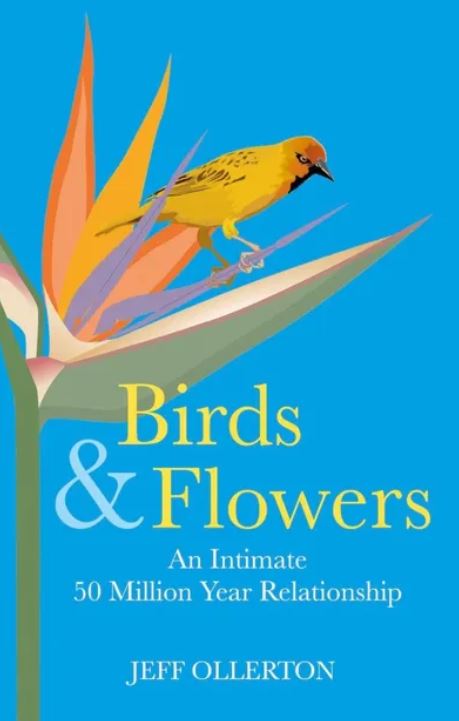Review of "Birds & Flowers: An Intimate 50 Million Year Relationship"
(by Jeff Ollerton)
DOI:
https://doi.org/10.26786/1920-7603(2024)793Abstract
No abstract required for Book Review
References
Bischoff M, Jürgens A, Campbell DR (2014) Floral scent in natural hybrids of Ipomopsis (Polemoniaceae) and their parental species. Annals of Botany 113:533-544 https://doi.org/10.1093/aob/mct279 DOI: https://doi.org/10.1093/aob/mct279
Campbell DR, Waser NM, Price MV (1996) Mechanisms of hummingbird-mediated selection for flower width in Ipomopsis aggregata. Ecology 77:1463-1472 https://doi.org/10.2307/2265543 DOI: https://doi.org/10.2307/2265543
Fulton M, Hodges S (1999) Floral isolation between Aquilegia formosa and Aquilegia pubescens. Proceedings of the Royal Society of London Series B 266:2247-2252 https://doi.org/10.1098/rspb.1999.0915 DOI: https://doi.org/10.1098/rspb.1999.0915
Kay KM (2006) Reproductive isolation between two closely related hummingbird-pollinated neotropical gingers. Evolution 60:538-552 https://doi.org/10.1111/j.0014-3820.2006.tb01135.x DOI: https://doi.org/10.1111/j.0014-3820.2006.tb01135.x
LoPresti EF, Goidell J, Mola JM, Page ML, Specht CD, Stuligross C, Weber MG, Williams NM, Karban R (2019) A lever action hypothesis for pendulous hummingbird flowers: experimental evidence from a columbine. Annals of Botany 125:59-65 https://doi.org/ DOI: https://doi.org/10.1093/aob/mcz134
1093/aob/mcz134
Ollerton J, Alarcon R, Waser NM, Price MV, Watts S, Cranmer L, Hingston A, Peter CI, Rotenberry J (2009) A global test of the pollination syndrome hypothesis. Annals of Botany 103:1471-1480 https://doi.org/10.1093/aob/mcp031 DOI: https://doi.org/10.1093/aob/mcp031
Ollerton J, Winfree R, Tarrant S (2011) How many flowering plants are pollinated by animals? Oikos 120:321-326 https://doi.org/10.1111/j.1600-0706.2010.18644.x DOI: https://doi.org/10.1111/j.1600-0706.2010.18644.x
Pauw A (2019) A bird's-eye view of pollination: biotic interactions as drivers of adaptation and community change. Annual Review of Ecology, Evolution and Systematics 50:477-502 https://doi.org/10.1146/annurev-ecolsys-110218-024845 DOI: https://doi.org/10.1146/annurev-ecolsys-110218-024845
Raguso R, Levin R, Foose S, Holmberg M, McDade L (2003) Fragrance chemistry, nocturnal rhythms and pollination syndromes in Nicotiana. Phytochemistry 63:265-284 https://doi.org/10.1016/S0031-9422(03)00113-4 DOI: https://doi.org/10.1016/S0031-9422(03)00113-4
Traveset A, Olesen JM, Nogales M, Vargas P, Jaramillo P, Antolin E, Trigo MM, Heleno R (2015) Bird-flower visitation networks in the Galapagos unveil a widespread interaction release. Nature Communications 6:6376 https://doi.org/10.1038/ncomms7376 DOI: https://doi.org/10.1038/ncomms7376
Waser NM, Chittka L, Price MV, Williams N, Ollerton J (1996) Generalization in pollination systems and why it matters. Ecology 77:279-296. https://doi.org/10.2307/2265575 DOI: https://doi.org/10.2307/2265575

Downloads
Published
How to Cite
Issue
Section
License
Copyright (c) 2024 Diane R Campbell

This work is licensed under a Creative Commons Attribution 4.0 International License.
JPE is an open access journal which means that all content is freely available without charge to the user or his/her institution.
Authors who publish with this journal agree to the following terms:
1) Authors retain copyright and grant the journal right of first publication with the work simultaneously licensed under a Creative Commons Attribution License that allows others to share the work with an acknowledgement of the work's authorship and initial publication in this journal.
2) Authors are able to enter into separate, additional contractual arrangements for the non-exclusive distribution of the journal's published version of the work (e.g., post it to an institutional repository or publish it in a book), with an acknowledgement of its initial publication in this journal.
3) Authors are permitted and encouraged to post their work online (e.g., in institutional repositories or on their website) prior to and during the submission process, as it can lead to productive exchanges, as well as earlier and greater citation of published work (See The Effect of Open Access).
To assure a broader targeted audience, content will be included into databases (such as EBSCO) and directories (such as DOAJ).











